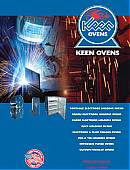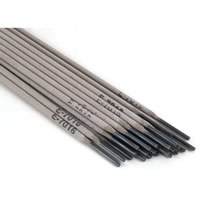Industrial Ovens
Front-Loading
![]() Under 10 cubic feet
Under 10 cubic feet
![]() 10-20 cubic feet
10-20 cubic feet
![]() Over 20 cubic feet
Over 20 cubic feet
![]() See All
See All
Top-Loading
![]() Under 10 cubic feet
Under 10 cubic feet
![]() 10-20 cubic feet
10-20 cubic feet
![]() Over 20 cubic feet
Over 20 cubic feet
![]() See All
See All
Learn About Our Industrial Ovens
Welding Ovens
![]() CONEX Storage
CONEX Storage
![]() Stick Electrodes
Stick Electrodes
![]() Sub-Arc Flux
Sub-Arc Flux
![]() Wire Spools
Wire Spools
![]() Tig Filler Wire
Tig Filler Wire
![]() Multi-Purpose
Multi-Purpose
![]() Nitrogen Purge
Nitrogen Purge
![]() See All
See All
 Order Our Free Catalog Today Click Here |
| Available Inventory |
Welding Rods Explained!
"Stick Welding" is also the term of choice in the field for SMAW, the acronym for Shielded Metal Arc Welding. Stick welding used to be done with a bare welding rod. It was very difficult, and could only be used in the flat position. If you've ever stuck a rod with flux on it, you can only imagine how many times they stuck bare rods! If the rod gets too close to the base metal it will decrease the voltage causing the arc to go out. Click here to view our welding ovens and to learn Sticking the welding rod is where the rod instead of melting like it should, sticks to the base metal. There is not enough current to melt it, but enough for it to stick. One way of getting it loose is immediately jerking the rod away from the base metal. If that doesn't work, you have to unclamp the rod, and then break it off. EVERYONE sticks welding rods when they're learning, and even old salts like me stick it every once and a while. I've always thought it was called stick welding because the electrode looked like a stick, but I read on Miller's website once that it's called stick welding because so many people stick it when learning. If you jerk the "stinger" (electrode holder) quick enough you can break the rod off of the base metal and re-strike your arc. But if it stays there too long and gets too hot, it will easily stick again and should be put down and allowed to cool. Many times when it sticks, the jerking away, or breaking loose of the rod will cause flux to come off of the end. That makes it really hard to strike and arc again without it sticking. Sticking the rod is SOME KIND of frustrating. I have a punching bag up in my shop for students to acquire good eye/hand coordination, but it's also a way for them to go let off some steam when they need to. One quick fix is to long-arc (hold the rod up off of the plate about a quarter inch) the welding rod and burn the bare metal off until it reaches the flux. . It helps to turn the machine up to warp 10 (in other words crank that baby up) when burning it off. If you don't do that, it will almost always stick again to the bare rod that you're trying to fix. That's one reason you really need to keep your welding rods, especially 7018 low-hydrogen rods, in rod ovens. If you don't, besides getting moisture in the flux, which causes porosity, or worm holes; the flux can become brittle and flake off. In another article, I'll explain about the most common kinds of welding rods used in the shop and field, as well as explaining some of the less used ones.
|
 There are a lot of different welding electrodes and
wires out there. In the field, welding electrodes are usually referred to as "welding
rods" so I will use that term here.
There are a lot of different welding electrodes and
wires out there. In the field, welding electrodes are usually referred to as "welding
rods" so I will use that term here.